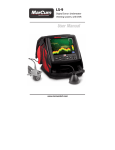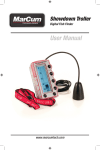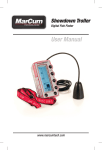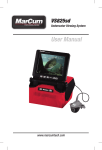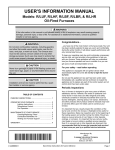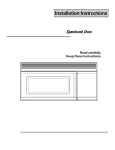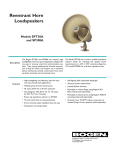Download Marcum Technologies VX-1P User's Manual
Transcript
USER MANUAL 3 COLOR SONAR ICE SYSTEM VX-1P MA-034-MK Rev A, Date: 9/2/08 www.marcumtech.com Table of Contents Introduction.............................................................................................................................................................................. 3 General Description ................................................................................................................................................................ 3 Ice System Set-Up .................................................................................................................................................................. 3 Open Water Set-Up................................................................................................................................................................. 3 High-Speed Transducer Installation .................................................................................................................................... 3 Puck Transducer Installation ............................................................................................................................................... 4 Operation................................................................................................................................................................................. 4 Ice System Only ...................................................................................................................................................................... 5 Signal Interpretation ................................................................................................................................................................ 5 Charging the Battery ............................................................................................................................................................... 5 User Tips ................................................................................................................................................................................. 6 Product Performance Specifications....................................................................................................................................... 6 One-Year Warranty ................................................................................................................................................................. 6 How to Obtain Service ............................................................................................................................................................ 6 MA-034-MK Rev A, Date: 9/2/08 www.marcumtech.com Ice System Set-Up Introduction Your VX-1 ice system requires some assembly prior to being ice ready. You will need to attach the sonar bracket to the ice shuttle, place the battery in the recessed tray, hook-up the positive and negative lead from the VX-1 power cord to the battery terminals, and route the transducer cable through the ice arm and connect to the back of the sonar unit. You will also need to place the unit in the enclosed softcase. Thank you for purchasing the MarCum VX-1 multicolor sonar unit. The VX-1 incorporates the latest in sonar technology, featuring 1000 watts of peak-to-peak power, patented signal interference rejection, auto zoom, and target separation down to 2.15 inches. Our goal is to set the industry standard for performance while maintaining the highest level of reliability. Please read this manual carefully before using your VX-1 system. Only by reading this manual can you realize the maximum benefit from your purchase — enjoy your new VX-1 sonar system! The transducer is weighted and will self-align when suspended from the adjustable ice arm. When ice conditions dictate (thick ice) you may suspend the ice ducer near the bottom of the hole to minimize sonar reflections. This generally occurs later in the season and when ice thickens to 24 inches or greater. General Description The VX-1 multi color sonar unit utilizes three different colors within its display to differentiate between densities of objects. The Red light displays the strongest of return signals, often signifying a hard bottom or a larger fish that is often in the center of the transmit signal (cone). The Orange light displays the next in the line of weakersignal returns, often signifying a softer bottom or smaller fish in the middle of the transmit signal or a larger fish on the outside of the transmit signal. The weakest return is displayed by a Green light and often signifies weeds, small bait-fish, medium-sized fish on the outside of the transmit signal, or a very soft bottom. The use of different colors in defining return signals is meant to be informative in indicating the size of fish, type of bottom or location of weeds. The interpretation of these signals improves with experience and use in the field. Open Water Set-Up The VX-1 is an excellent sonar unit for open-water use. To convert the VX-1 from an ice system to an open water unit, remove the VX-1 powerhead from the electronics shuttle. A new gimbal bracket is supplied with the open water transducer kit and can be mounted on any flat surface. The unit should be mounted in a location that is free from other electrical apparatus to eliminate interference. If interference is observed, reposition the unit until optimum performance is obtained. Your boat’s 12-volt DC electrical system can be used to power the unit. A power buss can be used, but interference may result. Interference is recognized as random flashes around the dial. Lowest noise will be obtained by direct connection to the battery. The VX-1 offers 12 levels of signal Interference Rejection (IR) from nearby competing units. This is most prevalent in ice-fishing applications where anglers utilizing sonar are often grouped together within small areas. The VX-1 is protected from accidental polarity reversals. No damage will result from an incorrect battery hook-up. The ice-fishing transducer supplied with the Ice System is not designed for open-water use. There are two transducer choices for use in open water. The highspeed transducer is designed for transom mounting (outside the hull) and reads depth while the boat is on plane. The puck-style transducer is most often mounted on the bottom of a trolling motor or epoxied into the hull of a fiberglass boat. The VX-1 can utilize any one of three different twentydegree (cone angle) transducers. The puck-style transducer is often used for mounting on the bottom of trolling motors or for in-hull applications. The high-speed transducer is intended for outside the hull mounting on the transom of a boat and is designed for picking up depth or return signals at higher speeds. High-Speed Transducer Installation High-Speed transducers are designed to be mounted on the transom of a boat. If properly installed, you will be able to read depth, weeds, and fish while the boat is on plane. Transducer mounting location is critical for optimum performance of the VX-1 sonar unit. The mounting location should be free of any white water or turbulence resulting from rivets, ribs or hull strakes. It is preferable to mount the transducer at least 18 inches from the centerline of the boat to avoid turbulent water resulting from the outboard motor. The transducer is wedge-shaped and should be mounted with the leading The ice transducer is a weighted, self-aligning transducer used for ice-fishing applications. The VX-1 runs off of any 12-volt power source and includes a power cord for wiring directly to the battery or into an electrical panel. The unit is mounted onto a factorysupplied gimbal bracket that can be in turn attached to a rotating swivel base (not supplied) or mounted directly to a boat deck, drivers console, portable electronics shuttle, or located in an electronics locker. The VX-1 is designed to withstand moisture from rain, sleet or snow. -3- www.marcumtech.com edge mounted against the transom. The leading edge of the transducer should be mounted flush with bottom of the boat. This can be best achieved by using a flat object like a ruler and holding it flat along the bottom of the boat and matching the bottom of the transducer to the bottom of the boat. Attach the mounting hardware to the highspeed transducer as shown in the instructions included with the transducer. Hold the transducer, with attached mounting hardware, to the transom of the boat (flush to the bottom) and mark the center of the holes on the transom. Drill the appropriate-size holes and attach the transducer to the transom. Tilt the rear of the transducer between 2 and 5 degrees below the transom to ensure solid contact with the water when the boat is on plane. It may be helpful to use a small amount of marine silicone along the leading edge of the transducer filling in any gap between the transducer and hull. This will help eliminate any white water or air bubbles, which can cause random interference on the sonar display. Operation The VX-1 utilizes a combination of control knobs (Gain & Range) and keypad (IR) and (ZM) to change or activate various system functions. The keypad has an audible beep when the key is depressed to indicate that a system function has been activated. The following is an explanation of the various system functions. Range Select - The Range select knob is used for turning the VX-1 on or off, as well as choosing the correct depth range. The VX-1 offers four depth ranges to choose from that can be selected by rotating the knob clockwise. The depth ranges are 20, 40, 80, or 160 feet. The depth-range setting is determined by turning the unit on and turning the Gain knob looking for a solid return (band of light) indicating bottom on the display. If no return is present, then select the 40-, 80-, or 160-foot range until a bottom reading is displayed on the screen. Gain Knob - The Gain knob controls the amount of sensitivity required by the unit to pick up objects like bottom, weeds, fish, smaller bait-fish, or small lures and jigs. The lower the number, the less sensitivity, conversely higher numbers mean more sensitivity. However, too much Gain (sensitivity) will result in too much information being displayed, and it becomes difficult to interpret the return signals. The best Gain setting is achieved by turning up your Gain from 0 until you receive a clear and steady bottom reading. If you’re looking for your lure or bait, turn up the gain until you just begin to display your bait without it fading or flickering on the screen. The lower the sensitivity, the narrower the display segments, the easier it is to distinguish targets. We cannot emphasize this strongly enough. Too much Gain will only clutter the display with unnecessary information, making it more difficult to interpret the return signals. Keeping the Gain at minimum levels will actually provide you with the most accurate and precise information. Use caution in applying silicone to ensure that it only comes in contact with the leading edge of transducer, and does not smear across the face of transducer resulting in reduced sensitivity. More-detailed installation instructions are included with the high-speed transducer and mounting hardware. Puck Transducer Installation Puck-style transducers can be mounted on the bottom of a trolling motor, epoxied in the hull of a fiberglass boat, or mounted to a suction cup for portable use. Mounting to a trolling motor is achieved with the use of a large, adjustable stainless steel hose clamp available at most hardware or automotive stores. Slots are included in the puck transducer for passing the clamp through and then around the motor. Align the transducer so that it is perfectly centered from right to left on the bottom of the motor. If the transducer is tilted or angled, you won’t receive a signal on your sonar display. Do not mount the transducer next to the propeller. Turbulence from the propeller may cause disruption in the sonar display. Inhull mounting is designed for achieving high-speed sonar readings in fiberglass boats. For the best readings, the transducer must be mounted in the layer of fiberglass that is in direct contact with the water. This is best achieved by mounting the transducer in the area surrounding the bilge pump in the transom area of the boat. Some boats have false bottoms or floors. Mounting the transducer in a location not in direct contact with the water will result in dead air space and no sonar reading. Once the correct area is located, the transducer is installed using a good grade of marine epoxy. For moredetailed installation information, refer to the directions included with the puck transducer. Interference Rejection - The Signal Interference Rejection system is designed to knock out competing return signals from other sonar units being used within close proximity. When other sonar units are causing interference to the display of the VX-1, activate the IR feature by depressing the IR key located on the face of the VX-1. There are 12 levels of interference rejection that can be used to knock out competing signals. Press the IR key to activate, each consecutive actuation (depressing the key) will change the level of signal rejection. Each actuation will result in an audible beep informing you that a system command has been recognized. The correct level of IR will be achieved when the display is clear of display clutter. In some extreme cases, clutter will be greatly reduced but not totally eliminated. -4- www.marcumtech.com Zoom - The VX-1 is equipped with a "bottom zoom" feature. When the ZM key is depressed the circular display is divided in half. The right half of the display (12 to 6 o’clock on the dial) will become the entire depth range (20, 40, 80, or 160 foot) you chose when turning the depth range knob to your desired depth setting. This will be indicated by a red light at the zero mark (12 o'clock) and another red light at 6 o'clock. These will be stationary and will not move while in the Zoom mode. The backside of the display (6 to 12 o'clock) is the other half of your split screen display. This is the Zoom window portion. The VX-1 comes with a bottom zoom that displays the bottom 5 feet in an expanded view. This expanded view of the bottom 5 feet is what is displayed on the left side of the split screen display (6 to 12 o'clock). For the Zoom to be activated, you must have a strong bottom return signal (Red) that equals or exceeds one foot on the display dial. If a strong return signal is not achieved the unit will not go into the Zoom mode. Repeat the process by turning up the gain and try again until Zoom is activated. Larger fish located in the center of the beam (cone) can appear RED and will be displayed as a wider band on the display. Smaller fish or fish on the outside of the cone may appear ORANGE or even GREEN. Fish moving through the transmit beam may change color as the return signal strengthens or weakens reflecting their location. Fish that are right on the bottom can appear as part of the bottom. The best indication of a fish sitting right on the bottom is that the leading edge of the bottom return signal is either ORANGE or possibly a dithering or flickering RED segment. It is important that the GAIN or sensitivity be kept to a minimum when displaying a strong bottom return. Too much GAIN will flood out the ability to differentiate targets and clutter the display. Ice System Only NOTE: Too much GAIN will cause clutter and may make it difficult to distinguish other targets like fish near the bottom. When tuning the unit to display lures or bait, make sure that the objects are in the center of the hole and therefore in the center of the transmit beam. If there’s water current (some lakes have underwater current or movement) and the lure doesn’t weigh much, it may move to the outer edge of the signal or out of the transmit beam altogether. This will make it difficult or impossible to pick it up on the display. Reading Lures or Bait - The VX-1 will pick up and display small objects like lures or bait. When tuning the unit to display your lure or bait, lower the object to the desired depth and turn up the GAIN until you see the lure or bait on the display. It is important that the GAIN be set so it displays the lure or bait as you raise or lower it. The “Ice System” comes with some additional features that require further explanation. Included in this system is an ABS electronics shuttle with recessed trays for transducer and battery, 12-volt / 7-amp sealed lead acid battery, wall charger with alligator clips, power cord, VX1 sonar unit, self-aligning transducer, and gimbal bracket with mounting knobs. Signal Interpretation Hard-bottom readings (rock or gravel) will be displayed by a wide band of RED light indicating a strong return signal. Conversely, a soft bottom (mud or silt) will return a weaker signal and will result in a narrower RED band or possibly even a combined RED and ORANGE band. A soft bottom with weed growth will often appear as a narrow RED or ORANGE band combined with both solid and broken GREEN segments indicating weeds. Any fish in the weeds may show as RED or ORANGE depending on fish size and relationship within the transmit beam (in the middle or on the outside of the transmit signal). Dead Zone - All sonar units will have a dead zone in certain circumstances. This occurs on sharp drop-offs where the transmit beam (cone) hits the shallower edge of the drop-off and returns before the deeper edge returns. This in effect creates an undisplayed area between the shallower and deeper water within the transmit beam. Charging the Battery To charge the battery, remove the negative and positive power leads attached to the battery. Attach the power leads with alligator clips to the appropriate battery posts. Basic charging guidelines are to charge the battery two hours for every three hours of use. If the battery is completely dead it may take up to 14-18 hours to reach full charge. The output of the charger is 500 mA or ½ amp. Do not leave the charger on for longer periods than needed. Although the charger is low output, it can still damage the battery if left on for extended periods of time after charge cycle is complete Reading Bottom - In interpreting depth, always read the leading edge (shallowest side) of the signal return. If you have a strong signal return (wide band of RED light) and it starts at 13 feet and ends at 16 feet, the correct depth is 13 feet or the shallowest leading edge of the return signal. Anything beyond the shallowest leading edge indicates the strength of the return signal. Reading Fish - Fish will generally appear as separate targets from the bottom. A fish target can be displayed as either RED, ORANGE or GREEN, depending on the size of the fish and the location within the transmit beam. -5- www.marcumtech.com 3.5 feet per 10 foot of depth. In 10 feet of water, the coverage is 3.5 feet; at a 20-foot depth, the signal beam is 7.0 feet across; and in 30 feet its 10.5 feet of coverage. User Tips Reading Through Ice - The VX-1 will provide accurate information reading through ice providing the ice is reasonably clear. Ice that appears milky or full of air bubbles will make it difficult or impossible to get an accurate reading. To send and receive the best signal, wet the ice with water to improve the coupling of the transducer to the ice. Please do not use anti-freeze or windshield washer fluid, because it pollutes the environment. Bottom can easily be determined without drilling holes, therefore greatly reducing time and energy in locating your fishing spot. Product Performance Specifications Output Power ...................... 1000 watts peak to peak Depth Ranges ..................... 20, 40, 80, & 160 feet Transmit Frequency ............ 200 Khz Current Draw....................... 250 mA Operating Voltage ............... 10.5 to 15 volts (12-volt DC) Fine Tuning Gain Control - To adjust gain properly, lower your lure or bait to within a foot of the bottom. Turn the gain up or down until the lure or bait shows as a steady green light. You should be able to raise or lower the lure in a jigging fashion without loosing the signal. If the gain (or sensitivity) is kept to a minimum, you should be able to separate targets down to 2.15 inches on the 20-foot scale. You may need to fine tune the gain each time you move locations, depending on the depth and bottom composition. Display Colors ..................... Red, Orange, Green Transducer Cone Angle ...... 20 degrees (all transducers) Target Separation ............... 2.15 inches (20-foot depth scale) One-Year Warranty Nature Vision, Inc. warrants this product to be free from defects in materials and workmanship for one year from the date of purchase. This warranty applies to customers who properly fill out and return the warranty card included with this manual. Failure to complete and return the warranty card voids the warranty. Nature Vision, Inc. will, at its sole discretion and without charging the customer, repair or replace any components that fail in normal use. Failures due to abuse, misuse, or unauthorized alteration, modification or repair are not covered. The warranty is valid only for the original owner who purchases the unit from an authorized dealer. Products purchased from on-line auction sites are not considered under warranty. Signal Interpretation - Sound waves emitted by the VX-1 bounce off targets and return with the strength of the targets’ density. Denser targets return with a stronger signal, displayed as RED. Less-dense objects (small fish) return a medium-strength signal, displayed as ORANGE. The least dense objects (weeds, bait-fish, lure) return a weak signal, displayed as GREEN. Objects on the edge of the sound cone may appear as yellow. A fish moving through the cone may appear first as green, then orange, then red, depending on its size and how close to the center of the cone it moves. Using the Ice Transducer - The weighted transducer suspends in the ice hole from the ice arm. The selfaligning transducer hangs like a plumb bob and always transmits and receives a direct signal. The transducer should be positioned just below the water line, except when the ice begins to get thick (more than 24 inches). Once the ice gets thicker than 24 inches, ringing off the side of the ice hole can occur. This is usually displayed as a solid band of light between 2 and 3 feet on the display dial. If this occurs, lower the transducer to the bottom of the ice hole. This should eliminate most display clutter. How to Obtain Service We want our products to provide you with a pleasant onthe-water experience. That means maximum customer satisfaction. If you have a problem with your unit please contact Nature Vision's toll free number at (866) 7770733 for a Return Authorization Number (RA#) or e-mail us at [email protected]. No service returns will be accepted without this pre-return authorization number, which must be clearly marked on the outside of the package. Nature Vision, Inc. retains the exclusive right to repair or replace the unit at its discretion. The customer is responsible for shipping costs associated with returning the unit to Nature Vision, Inc. Nature Vision, Inc. will pay for shipping the repaired unit back to the customer while it is still under warranty. All out of warranty services will be charged a fee for service and shipping which must be paid in advance. After obtaining a Return Authorization number, the unit should be securely packed and shipped “pre-paid freight” and insured to Nature Vision, Inc. It is the consumers' full Battery Draw - The VX-1 has a current draw between 250 and 300mA per hour. With a standard 7-amp hour battery, the VX-1 should last between 20 and 28 hours if fully charged. To extend the battery life, it is preferable to recharge the battery after every use. Cone Angle Coverage - The cone angle of all VX-1 transducers is 20 degrees. A general rule of thumb is that the coverage (distance across the signal beam) is -6- www.marcumtech.com responsibility to track their products sent out in the mail or other forms of delivery service. Nature Vision Inc. will not be liable for lost packages sent out in the mail. Unless specified otherwise, do not include batteries or other accessories when returning the product for repair. Nature Vision, Inc will not be responsible for lost or damaged accessories. Please allow a minimum of 10 business days to complete your repair. Nature Vision, Inc. 1480 Northern Pacific Road Brainerd, MN 56401 RA#____________ Note: The RA number must be clearly marked on the outside of the package Canadian customers please return to: FTN C/O Nature Vision Inc. 7075 Ordan Drive Mississauga, ON L5T 1K6 RA#____________ Note: The RA number must be clearly marked on the outside of the package -7- -8-



















